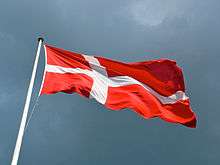National symbol
| Part of a series on |
| Nationalism |
|---|
|
Core values |
|
Organizations |
| Politics portal |
A national symbol is a symbol of any entity considering itself and manifesting itself to the world as a national community: the sovereign states but also nations and countries in a state of colonial or other dependence, (con)federal integration, or even an ethnocultural community considered a 'nationality' despite having no political autonomy.[1]
National symbols intend to unite people by creating visual, verbal, or iconic representations of the national people, values, goals, or history.
These symbols are often rallied around as part of celebrations of patriotism or aspiring nationalism (such as independence, autonomy or separation movements) and are designed to be inclusive and representative of all the people of the national community.
Common official national symbols

- The flag or banner of a nation-state.
- The coat of arms of the land or ruling dynasty.
- The seal or stamp of the land or ruling dynasty.
- The head of state.
- The associated device and motto can also be used separately.
- The national colors, often derived from the above.
- Abstract symbols, especially crosses.
- National anthems, royal and imperial hymns; alongside such official hymns custom may also recognize the national symbol value of very popular songs.
Unofficial national symbols
In many ways, well-known sights in a country can also be seen as national symbols, as can traditional items of handicraft, folk costumes, natural monuments, national epics and national myths, as well as symbols used by national sports teams and their supporters.
See also
References
- ↑ "England's National Symbols". england.org.za. Retrieved 18 September 2012.
National symbols are defined as the symbols or icons of a national community (such as England), used to represent that community in a way that unites its people.